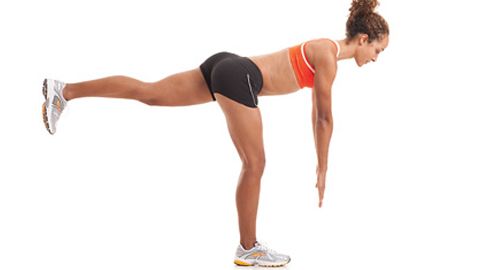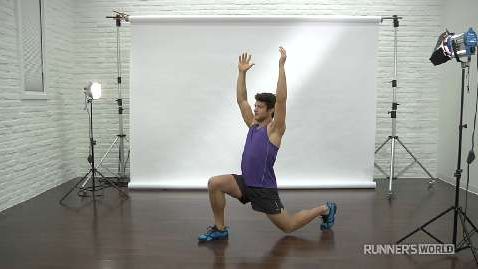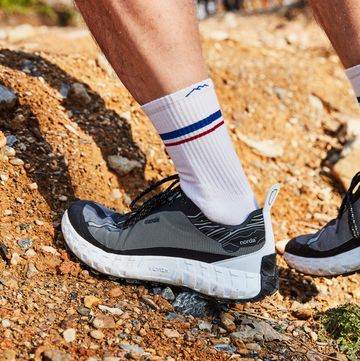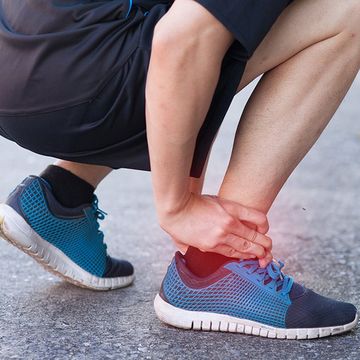The hip bone’s connected to the…well, seemingly everything if you’re a runner. Research has found weak and/or tight hips to be associated with common injuries such as runner’s knee, iliotibial band syndrome, and gluteal pain. A new study has found a link even farther down the body: the Achilles tendons.
In research that will be published in Medicine & Science in Sports & Exercise, Australian biomechanists compared the hip mechanics of runners with Achilles tendinopathy to otherwise similar runners who were symptom-free. (Achilles tendinopathy is a catch-all term for pain and tendon damage in the area.) The researchers found that the hips of those with Achilles pain moved in less-desirable ways when they ran.
On average, the runners with Achilles pain had greater hip instability, as measured by factors such as external hip rotation. This was the case even though all the runners had similar hip and joint angles and ankle activity when running at about 6:40 per mile pace. Relatively unstable movement patterns like those found in the runners with Achilles pain can not only increase injury risk but also increase the energy cost of running, making you slower at a given effort level.
This was a retroactive study, meaning that the runners with Achilles pain already had that condition when their hip mechanics were evaluated. That being the case, it’s impossible to know whether weak hips led to developing Achilles problems (because of lower-leg structures having to pick up some of the work the hips should be doing), or if lower-leg limitations caused compensatory changes in hip mechanics. As lead researcher Mark Creaby, Ph.D., told Runner’s World by email, “I’m sure you know how much we scientists don’t like to speculate too much!”
Still, Creaby offered an analogy to explain how Achilles pain might start with the hips.
“Consider throwing a ball,” he said. “How far we are able to throw a ball is related not just to what we do with our wrist, but also the work we do with our trunk, shoulders, and elbow. Similarly, in the lower limbs, control of movement at the ankle is down to the work we do at not just the ankle, but also the knee and the hip. Our data show that the hips are working that bit harder in runners [with Achilles tendinopathy], and this may help them to compensate for potential dysfunction at the ankle. It could be that in some runners reduced work from the hip places a greater demand on the ankle, and with this increased load on the Achilles.”
Physical therapist Daniel Frey, author of The Runner’s Guide to a Healthy Core, is more willing to name the hips as the culprit in the majority of Achilles cases he sees.
“Seventy-five percent of the time, if not more, runners with Achilles problems have coinciding hip and core limitations,” Frey says. “Poor hip flexibility, specifically extension, leads to poor gluteal recruitment and an overload of the calf complex, leading to Achilles problems. So, underlying biomechanical deficiencies in the hip often precede Achilles problems.”
As it turns out, Frey’s contention is supported in part by earlier research by Creaby and his team. In 2013, they published a study that found that the glutes in runners with Achilles pain fired later and for less time than those in runners without Achilles pain.
Creaby and Frey agree that runners with Achilles problems should do exercises aimed at improving hip and glute mechanics. The first video below shows a simple but effective glute-strengthening routine.
The series of videos below shows exercises that will increase strength and range of motion in your hip flexors, thereby leading to the greater hip extension Frey advocates.

Scott is a veteran running, fitness, and health journalist who has held senior editorial positions at Runner’s World and Running Times. Much of his writing translates sport science research and elite best practices into practical guidance for everyday athletes. He is the author or coauthor of several running books, including Running Is My Therapy, Advanced Marathoning, and Meb for Mortals. Scott has also written about running for Slate, The Atlantic, the Washington Post, and other members of the sedentary media. His lifetime running odometer is past 110,000 miles, but he’s as much in love as ever.








